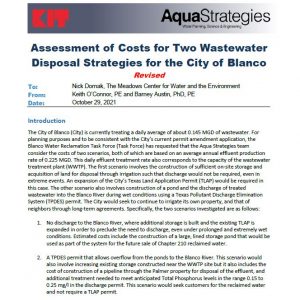Assessment of Costs for Two Wastewater Disposal Strategies for the City of Blanco – Revised

This memo is in response to the priorities identified by the Blanco Water Reclamation Task Force, a collaboration between the City of Blanco, Protect Our Blanco, and the Meadows Center for Water and the Environment.
Introduction:
The City of Blanco (City) is currently treating a daily average of about 0.145 MGD of wastewater. For planning purposes and to be consistent with the City’s current permit amendment application, the Blanco Water Reclamation Task Force (Task Force) has requested that the Aqua Strategies team consider the costs of two scenarios, both of which are based on an average annual effluent production rate of 0.225 MGD. This daily effluent treatment rate also corresponds to the capacity of the wastewater treatment plant (WWTP). The first scenario involves the construction of sufficient on-site storage and acquisition of land for disposal through irrigation such that discharge would not be required, even in extreme events. An expansion of the City’s Texas Land Application Permit (TLAP) would be required in this case. The other scenario also involves construction of a pond and the discharge of treated wastewater into the Blanco River during wet conditions using a Texas Pollutant Discharge Elimination System (TPDES) permit. The City would seek to continue to irrigate its own property, and that of neighbors through long-term agreements. Specifically, the two scenarios investigated are as follows:
1. No discharge to the Blanco River, where additional storage is built and the existing TLAP is expanded in order to preclude the need to discharge, even under prolonged and extremely wet conditions. Estimated costs include the construction of a large, lined storage pond that would be used as part of the system for the future sale of Chapter 210 reclaimed water.
2. A TPDES permit that allows overflow from the ponds to the Blanco River. This scenario would also involve increasing existing storage constructed near the WWTP site but it also includes the cost of construction of a pipeline through the Palmer property for disposal of the effluent, and additional treatment needed to meet anticipated Total Phosphorus levels in the range 0.15 to 0.25 mg/l in the discharge permit. This scenario would seek customers for the reclaimed water and not require a TLAP permit.